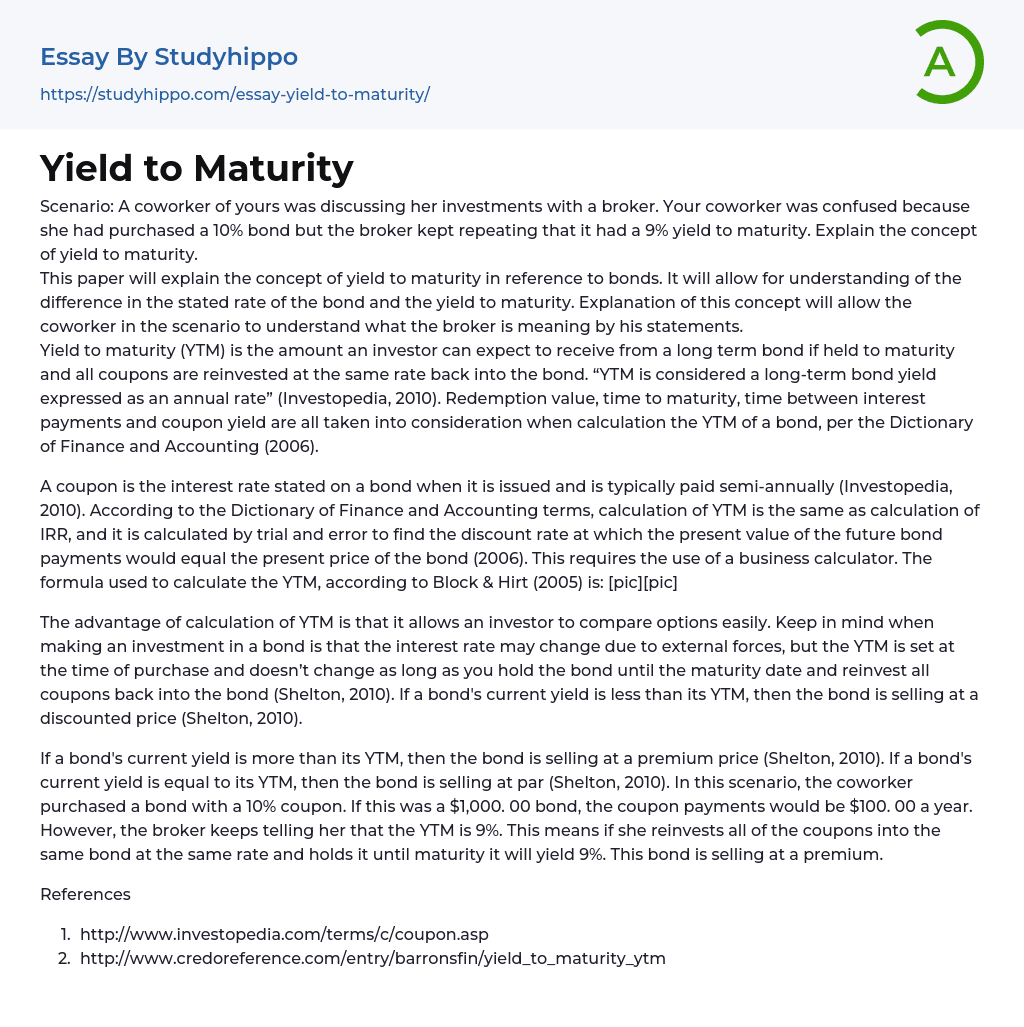Yield to maturity (YTM) is the amount an investor can expect to receive from a long term bond if held to maturity and all coupons are reinvested at the same rate back into the bond. “YTM is considered a long-term bond yield
...expressed as an annual rate” (Investopedia, 2010). Redemption value, time to maturity, time between interest payments and coupon yield are all taken into consideration when calculation the YTM of a bond, per the Dictionary of Finance and Accounting (2006).
A coupon is the interest rate stated on a bond when it is issued and is typically paid semi-annually (Investopedia, 2010). According to the Dictionary of Finance and Accounting terms, calculation of YTM is the same as calculation of IRR, and it is calculated by trial and error to find the discount rate at which the present value of the future bond payments would equal the present price of the bond (2006). This requires the use of a business calculator. The formula used to calculate the YTM, according to Block & Hirt (2005) is: [pic][pic]
The advantage of calculation
of YTM is that it allows an investor to compare options easily. Keep in mind when making an investment in a bond is that the interest rate may change due to external forces, but the YTM is set at the time of purchase and doesn’t change as long as you hold the bond until the maturity date and reinvest all coupons back into the bond (Shelton, 2010). If a bond's current yield is less than its YTM, then the bond is selling at a discounted price (Shelton, 2010).
If a bond's current yield is more than its YTM, then the bond is selling at a premium price (Shelton, 2010). If a bond's current yield is equal to its YTM, then the bond is selling at par (Shelton, 2010). In this scenario, the coworker purchased a bond with a 10% coupon. If this was a $1,000. 00 bond, the coupon payments would be $100. 00 a year. However, the broker keeps telling her that the YTM is 9%. This means if she reinvests all of the coupons into the same bond at the same rate and holds it until maturity it will yield 9%. This bond is selling at a premium.
References
- http://www.investopedia.com/terms/c/coupon.asp
- http://www.credoreference.com/entry/barronsfin/yield_to_maturity_ytm
- Bank essays
- Banking essays
- Corporate Finance essays
- Credit Card essays
- Currency essays
- Debt essays
- Donation essays
- Enron Scandal essays
- Equity essays
- Financial Accounting essays
- Financial Crisis essays
- Financial News essays
- Financial Ratios essays
- Financial Services essays
- Forecasting essays
- Foreign Exchange Market essays
- Free Market essays
- Gold essays
- Investment essays
- Legacy essays
- Loan essays
- Market Segmentation essays
- Money essays
- Personal finance essays
- Purchasing essays
- Retirement essays
- Shareholder essays
- Stock Market essays
- Supply And Demand essays
- Venture Capital essays
- Adult essays
- Aggression essays
- Altruism essays
- Archetype essays
- Behavior essays
- Certainty essays
- Conformity essays
- Deception essays
- Human Behavior essays
- Human Sexuality essays
- Maturity essays
- Morality essays
- Obedience essays
- Procrastination essays
- Reinforcement essays
- Role Model essays




